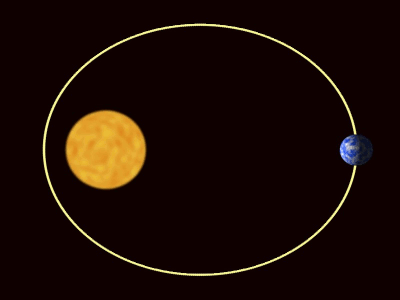Difference between revisions of "Orbit"
| Line 1: | Line 1: | ||
==Key Stage 2== | ==Key Stage 2== | ||
===Meaning=== | ===Meaning=== | ||
| − | An [[Orbit]] is the path | + | An [[Orbit]] is the path [[planet]] takes around a [[star]] and the path a [[moon]] takes around a [[planet]]. |
{| class="wikitable" | {| class="wikitable" | ||
|- | |- | ||
| Line 13: | Line 13: | ||
: [[The Moon]] [[orbit]]s the [[Earth]]. This means [[The Moon]] takes a circular path around the [[Earth]]. | : [[The Moon]] [[orbit]]s the [[Earth]]. This means [[The Moon]] takes a circular path around the [[Earth]]. | ||
: All the [[planet]]s orbit [[The Sun]]. This means the [[planet]]s take a circular path around [[The Sun]]. | : All the [[planet]]s orbit [[The Sun]]. This means the [[planet]]s take a circular path around [[The Sun]]. | ||
| + | |||
| + | ==Key Stage 3== | ||
| + | ===Meaning=== | ||
| + | An [[Orbit]] is the path an [[asteroid]], [[comet]], [[planet]] or [[dwarf planet]] takes around a [[star]] and the path a [[moon]] takes around a [[planet]]. | ||
| + | |||
| + | ===About Orbits=== | ||
| + | : [[Moon]]s [[orbit]] [[planet]]s and [[planet]]s [[orbit]] the [[stars]] due to [[gravity]]. | ||
| + | : [[Isaac Newton|Newton]] was the first person to realise that [[object]]s were held in [[orbit]] by [[gravity]] which he [[explain]]ed in his [[Newton's Universal Theory of Gravitation|Universal Theory of Gravitation]]. | ||
| + | : [[Gravity]] is a constant [[force]] directed to the centre of a [[massive]] [[object]]. | ||
| + | : [[The Moon]] feels a [[force]] pulling it towards the centre of the [[Earth]]. The [[Earth]] feels a [[force]] equal in [[magnitude]] but opposite in direction to that of [[The Moon]]. | ||
| + | |||
| + | {| class="wikitable" | ||
| + | |- | ||
| + | |[[File:Orbit1.gif|center|400px]] | ||
| + | |- | ||
| + | | style="height:20px; width:400px; text-align:center;" |The [[planet]]s are pulled towards [[The Sun]] by [[gravity]]. | ||
| + | |} | ||
| + | |||
| + | ==Key Stage 4== | ||
| + | ===Meaning=== | ||
| + | An [[orbit]] is the [[circle|circular]] or [[ellipse|elliptical]] path that an [[object]] takes a more [[mass|massive]] [[object]] due to a [[force]] of attraction acting between them. | ||
Revision as of 09:27, 12 March 2019
Contents
Key Stage 2
Meaning
An Orbit is the path planet takes around a star and the path a moon takes around a planet.
| A Planet orbiting a Star. |
About Orbits
- An orbit is a roughly circular path, but can be stretched out into an oval shape.
- The Moon orbits the Earth. This means The Moon takes a circular path around the Earth.
- All the planets orbit The Sun. This means the planets take a circular path around The Sun.
Key Stage 3
Meaning
An Orbit is the path an asteroid, comet, planet or dwarf planet takes around a star and the path a moon takes around a planet.
About Orbits
- Moons orbit planets and planets orbit the stars due to gravity.
- Newton was the first person to realise that objects were held in orbit by gravity which he explained in his Universal Theory of Gravitation.
- Gravity is a constant force directed to the centre of a massive object.
- The Moon feels a force pulling it towards the centre of the Earth. The Earth feels a force equal in magnitude but opposite in direction to that of The Moon.
| The planets are pulled towards The Sun by gravity. |
Key Stage 4
Meaning
An orbit is the circular or elliptical path that an object takes a more massive object due to a force of attraction acting between them.
